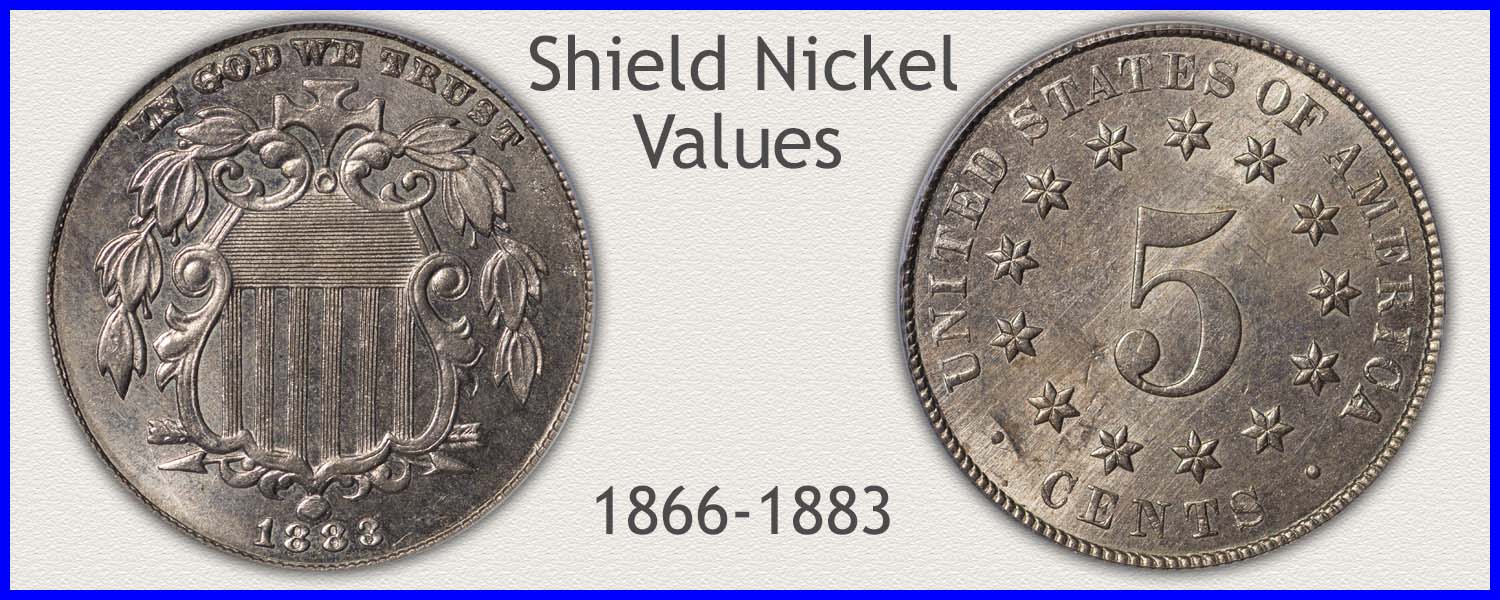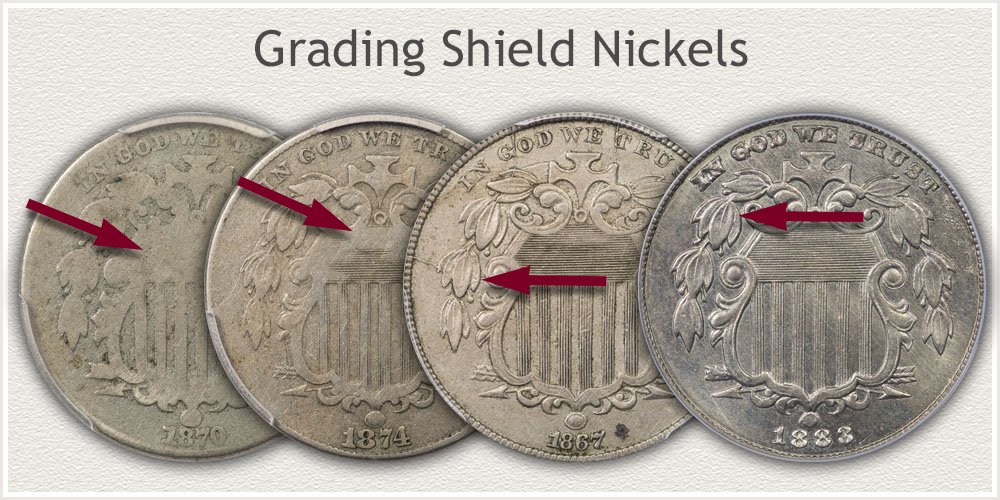Coin Values Moving with Precious Metals: Up-Dated 12/29/2025: Gold $4449 | Silver $75.46
1882 Nickel Value
The perfect example of the Shield Nickel series. 1882 nickel value is strong and well supported by the coin market. This is a very popular year; many levels of collectors seek these for their collections. Use the step-by-step method outlined below. Evaluate and record subtle elements, finding the narrow value on the chart.
A coin's surface is a strong indication of its quality. Matching your coin to a series of images determines its condition. Describing further details helps understand a coin's appeal to the market. Combined, these provide a recorded and accurate description. Quality of the coin is now known.
To see its potential, begin with a review of the chart listing the range of how much an 1882 nickel is worth.
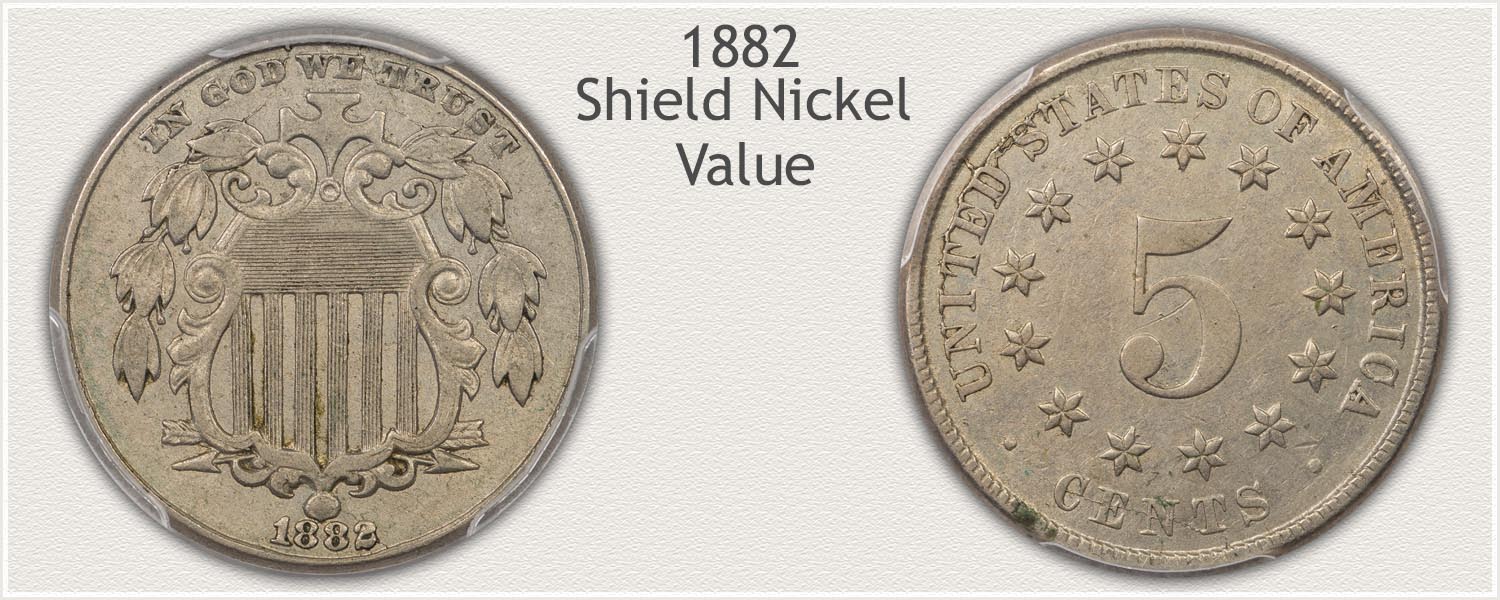
Steps Leading to Value:
- Step 1: Date Identified - Because of its availability and quality, this date is an important year of the series. Double check to confirm a popular nickel.
- Step 2: Grading Condition - The "grade" narrows premiums as listed on value charts. A key step in evaluating a coin's potential.
- Step 3: Special Qualities - Identify those special nickels well preserved and handled over time. Original surface condition is a surprisingly scarce feature remaining on Shield nickels.
| 1882 Nickel Value | ||||
|---|---|---|---|---|
| Condition of Coin | ||||
| Date | Good | Fine | Extremely Fine |
Mint State |
| 1882 Nickel Value Updated | 2025 | |||
| 1882 | $22 | $27 | $57 | $113 |
The above chart lists a range of wholesale values these nickels trade within the market. Note, because of scarcity, small improvements in preservation have an impact on premiums.
Step 1: A Popular Collectible of the Shield Series
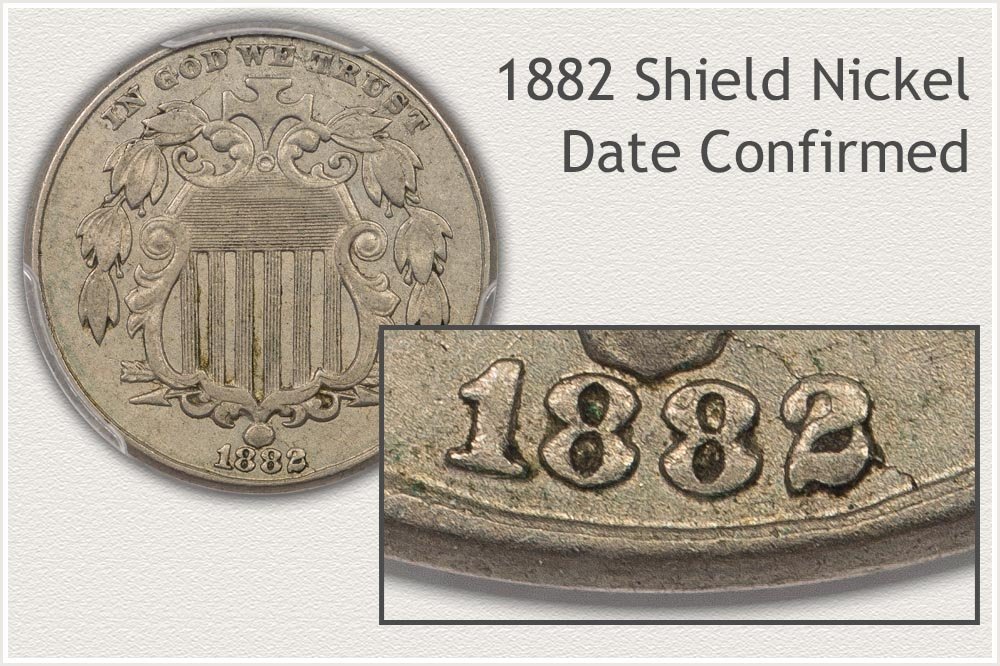
Mintage of Shield nickels were either very large quantities or very small numbers. 1882 nickels, with over 11.4 million produced, are part of the high mintage group. Philadelphia, continued the trend of being the only mint striking "minor" coins. Their large production of nickels allows many to remain today. Of note, collectors find these 1882 nickels well made, showing strong, clear details. A nice quality coin is both obtainable and affordable.
On a rarity scale, 1882 nickels are part of the available dates within the series. Premiums across the condition scale, represent the base value of Shield nickels. 1882 nickels remain popular because of availability, affordable value, and strike quality. This date is often chosen by collectors to represent the first, nickel five cent coinage.
A second inspection confirms the date. These small numerals are difficult to recognize. Magnify the area under the shield when verifying the date.
Step 2: | Locate and Confirm Details Defining a Grade
Images Help Identify Condition and Value of an 1882 Nickel
An 1882 Shield nickel in well preserved condition is a prize for collectors. A standard process used by collectors examines these nickels when judging condition. Collectors are looking at specific features, intent on finding examples with ample detail. Shield nickels are somewhat scarce overall; eye pleasing examples are a true challenge.
The condition of a coin is rated into different "grade" categories. An example is "Mint State" grade nickels, defining a coin without any wear to the surface. At the other end of the scale, are "Good" grade pieces showing heavy wear. These grading terms fill in an important part of the 1882 nickel's description.
Find an image below closely matching the condition of your coin. Each image is a professionally graded coin. These coins represent the coin market's expectation of their condition. Locating visible detail, as described, further confirms the correct grade rating.
Mint State Grade
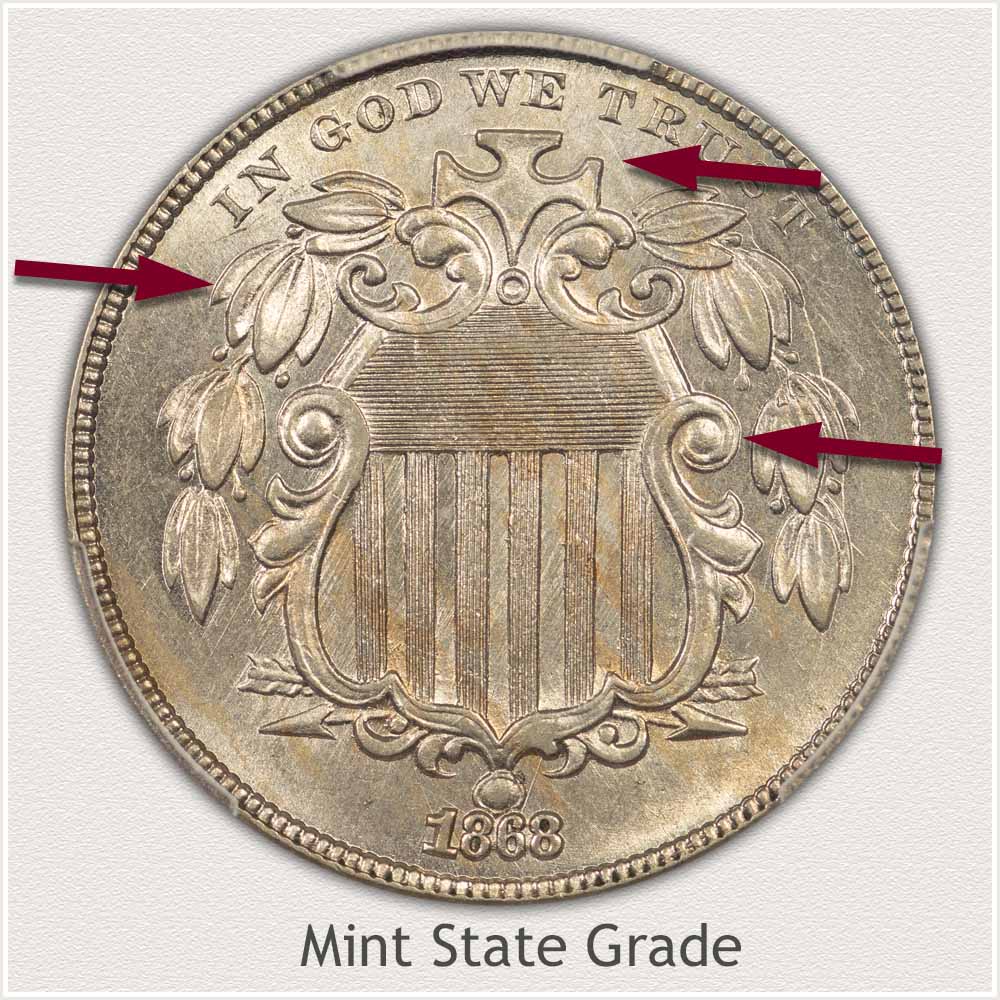
Mint State: A Shield Nickel in "Mint State" grade is a coin showing no signs of wear on its surface. When you tilt the coin under a light, a bright luster radiates across the entire surface. Any breaks or interruptions in the luster indicate worn areas. Three main areas are carefully inspected for signs of wear. These are the shield's frame, the olive leaves, and cross at the top of the coin.
Locate the cross raised high above the field at the top of the coin. Examine the example image. Both the cross and the field have a matching texture and shine. When a coin is unworn, the metal of the cross remains intact, and the field below is reflective. Look for similarities in texture and luster on the cross and the field. Any smoothness or a dull appearance on the cross indicates wear.
Next, examine the two olive branches on either side of the shield. Each branch is a series of leaf groups. In Mint State condition all leaves are crisp and well-defined. When looking closely, there is no flattening along their raised edges. Inspect the group of leaves on the left side of the shield near the horizontal lines. This is a particularly high point of the design.
To confirm the grade, the frame device that surrounds the shield is intact. This detailed design has deep contours with rounded tops, all remaining undisturbed. Texture and luster of the metal are consistent overall. A focal point is the "ball" element within the scroll near the horizontal lines. These show no signs of smooth metal or flatness at the peak of their contours.
An important part of your examination is tilting the coin under a single light source. This is a standard technique within the hobby. Different angles of light help judge and highlight any wear on the surface. A Mint State coin displays an unbroken, consistent luster. Luster radiates across the raised elements and lower field. Any dulling, or breaks in the luster on the cross, leaves, or frame are signs of wear.
Extremely Fine Grade
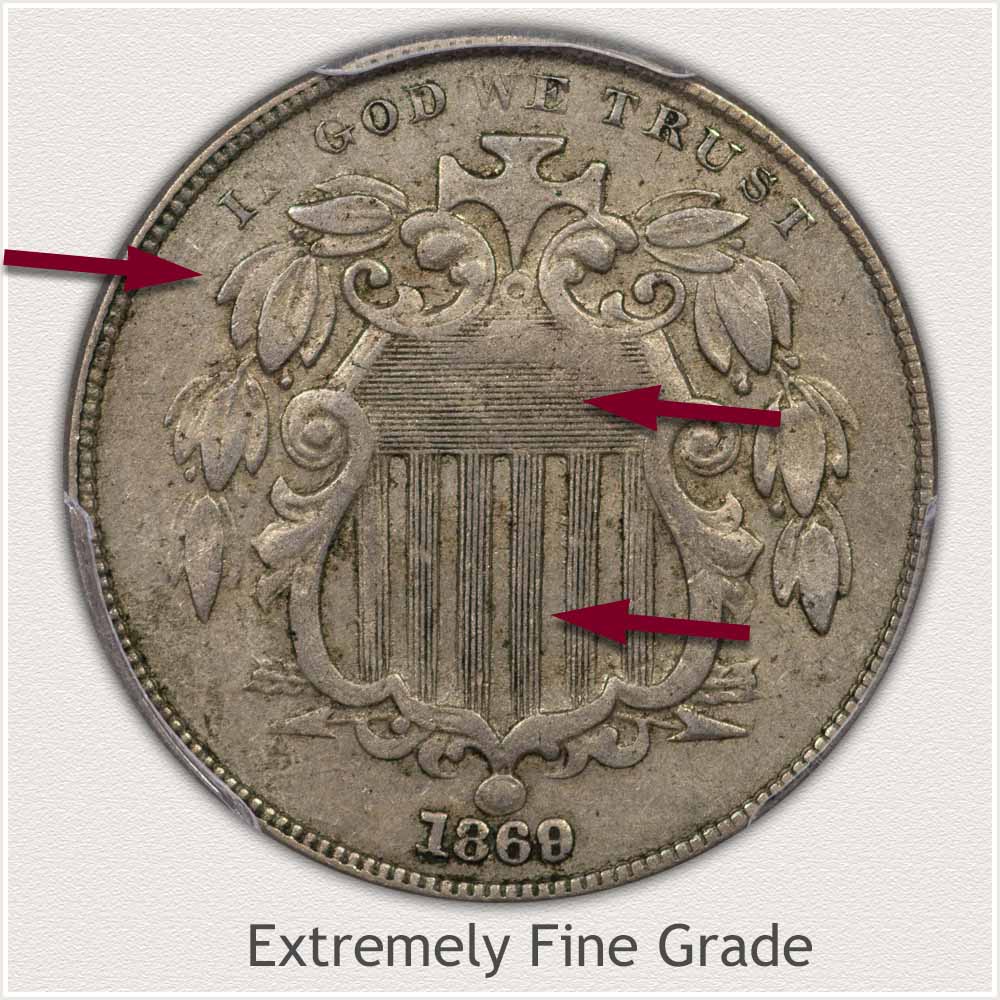
Extremely Fine: Defining the grade, only small spots of flat metal smooth the highest areas of the design. Grading under a single light with magnification, provides contrast and key details. Examine two main areas, the inner lines of the shield and quality of the leaves. These detailed features provide measurable areas indicating the level of wear.
First, inspect the vertical and horizontal lines within the shield. At the Extremely Fine level, these lines are crisp and well-defined. Allowable for the grade are a few isolated areas of faded sharpness. The horizontal lines often show the most weakness. When vertical lines are very clear, this offsets the faded areas above. Compare your coin to the example image of an Extremely Fine Shield Nickel. This helps gauge the overall condition found on coins at the grade level.
Next, to examine are the leaves on the sides of the shield. Each leaf remains complete, with visible and bold edges. Full separation of the leaves is a standard requirement for the grade. Inspect both sides of the shield to ensure this level of detail is present.
While examining the leaves, light wear causes only a slight flatness at the leaf ends. The key grading metric is smoothness on the highest points only. Veins within the leaves display boldness when sitting in a lower contour with a defined edge.
One subtle consideration is an uneven strike to the design during minting. Often, leaves on one side of the shield show more detail than the other. To accurately measure wear, judge the better side first. This sharper side gives a clearer indication of the coin's original detail and extent of wear.
Meeting the standards of well-defined lines within the shield indicates a quality nickel. Minimal wear on leaf edges and clear separation of each leaf confirms a premium 1882 nickel.
Fine Grade
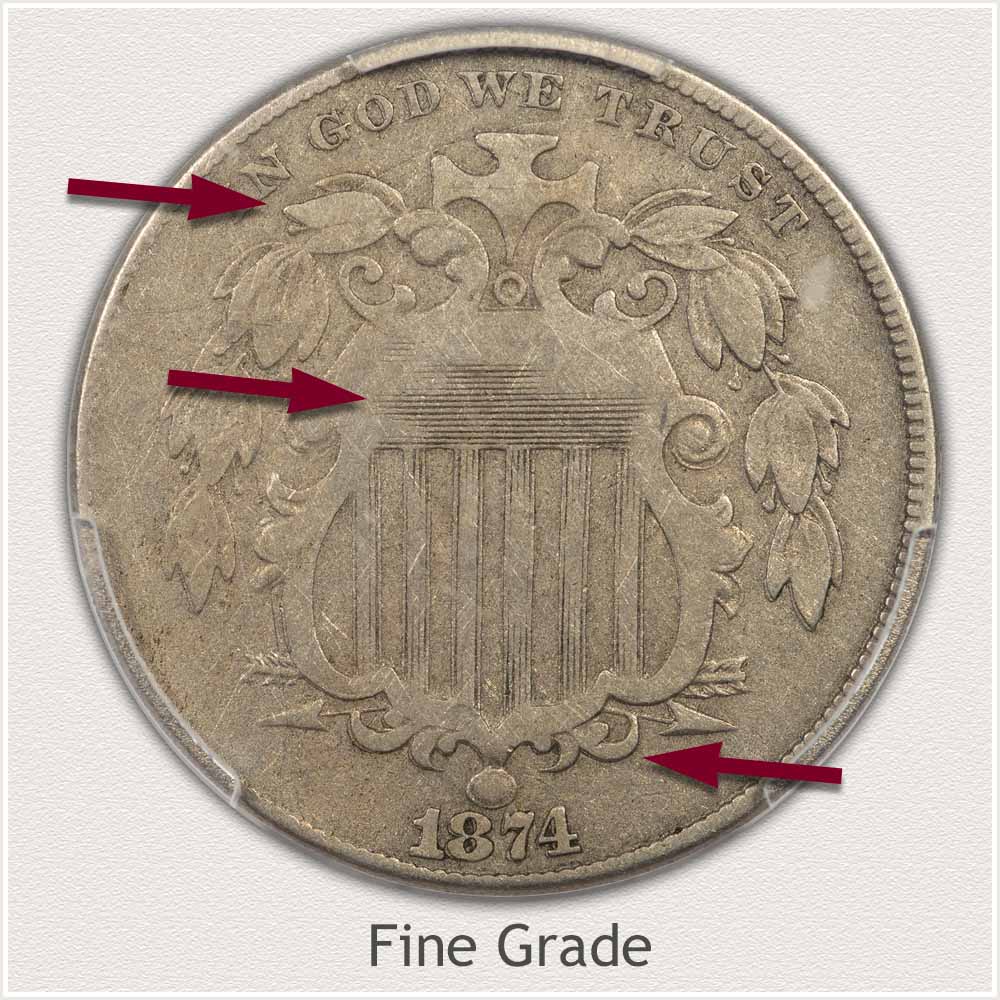
Fine Grade: Moderate wear smoothing parts of high points defines the "Fine" grade condition of a Shield nickel. Key areas inspected are the horizontal lines, shield border, and leaf detail on the olive branches. These provide measurable amounts of remaining detail, helping narrow the grade range.
Beginning just above the date, intricate frame details are flat, only an outline. However, the outline is bold, with recognizable arrow heads and tail feather features. There are no parts of the frame faded into the field of the coin.
Next, inspect the upper half of the shield. Vertical and horizontal lines within the shield are partially visible. Half of the horizontal lines remaining is the metric to measure. Notability, the lower portion of the horizontal lines typically appear sharp. Vertical lines show very well. Most of the lines are crisp, although some fading in areas meets the grade category.
The leaf detail on the olive branches provides measurable wear points. At this grade level, high points of the leaves show moderate flatness. This smooth area begins at the leaf tips and extends halfway across the leaf. Edges of the leaves are mostly defined. Upper leaves remain separate from the lower leaves. Note on the example, some merging of leaf edges, particularly in the upper left area of the coin. This is acceptable if most leaves are boldly defined.
Compare your Shield Nickel to the professionally graded example to confirm its condition. This comparison method provides a good reference helping identify subtle grading points.
Good Grade
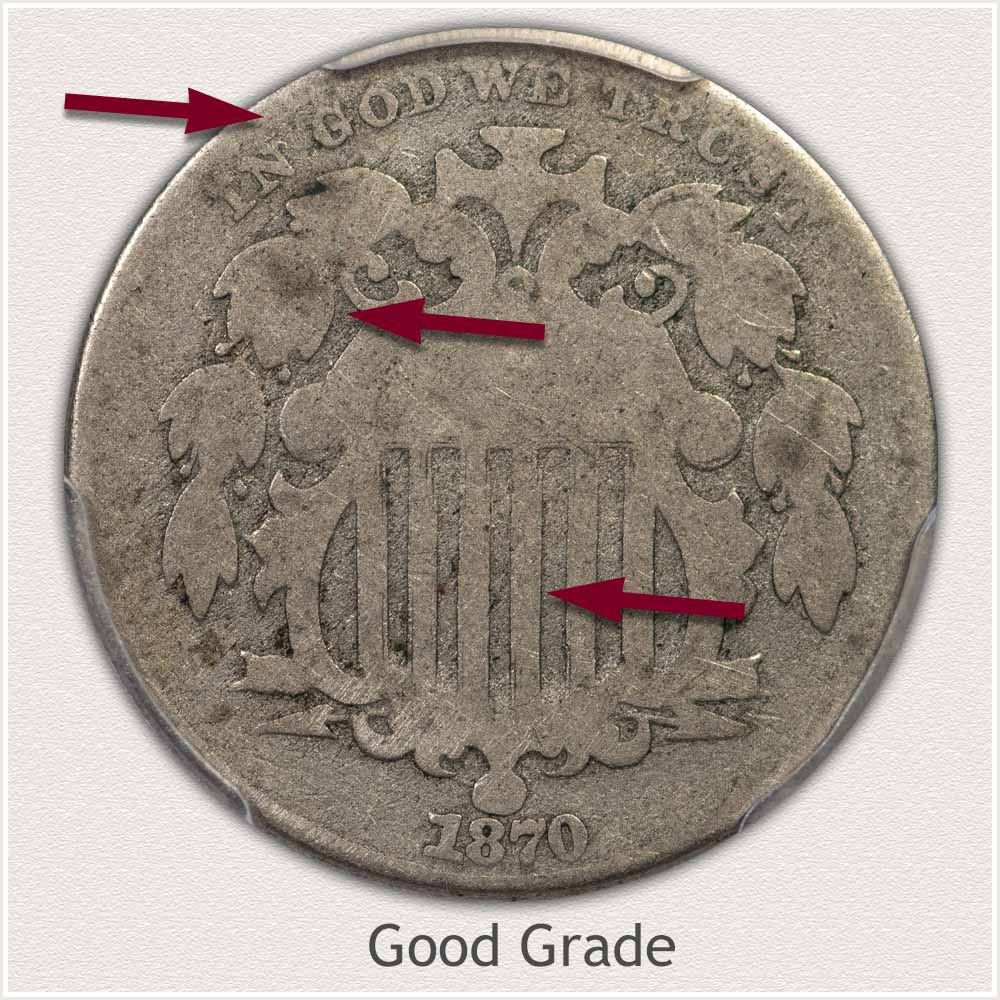
Good Grade: A Good grade 1882 Shield nickel exhibits heavy wear on major features of the coin's design. A well-worn appearance defines the grade. Only the outer edges of the design elements rise slightly from the field of the coin. Essential are a readable date and a legible motto.
The motto, "In God We Trust" is a key factor used to grade condition. Located at the top edge, note in the example image, a slight fading. It does remain legible, only the upper half of the letters are indistinct. With a bold date remaining, these two features measure the level of wear at the grade standard. Both add to the coin's visual appeal and market acceptance of grade.
Overall, heavy wear reduces the rim of the coin into the field in places. A partially missing rim still allows for a Good grade rating. Required are a full outline of major features and a legible motto.
Inspecting inward, the leaves of the wreath are smooth and without detail. These are now "groups" without any lines defining individual leaves. The outer edge of the shield remains, although the shield is flat without minor elements. The presence of strong vertical stripes defines a recognizable shield device.
Despite a mostly smooth surface, major features rise above the field with complete outlines. No major elements fade into the background. These condition nickels have an aesthetic appeal. They fit within the collectible range and enjoy premium values.
How to Video: Grading Shield Nickels
Step 3: | Special Qualities | Handling and Storage Maintains Value
Shield Nickels Need Special Handling
Old U.S. coinage requires proper handling and storage to maintain their value. Handling techniques plus how and where these coins are stored play a role in keeping them safe. The coin hobby offers various products for organizing and storing coins.
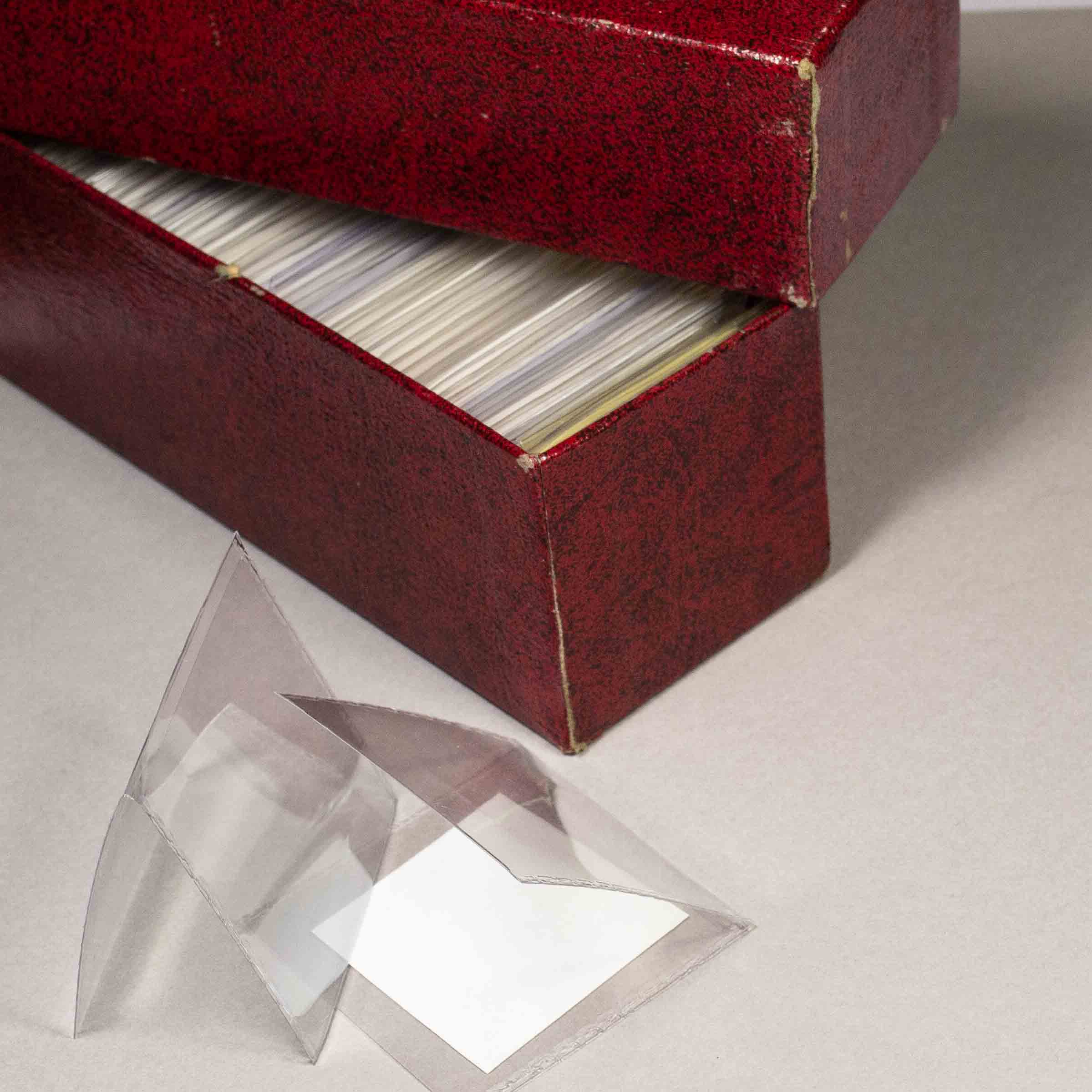 Coin Supplies to House and Protect Shield Nickels
Coin Supplies to House and Protect Shield Nickels
First addressed is how to handle collectible nickels. Because of high minimum value, handle all Shield nickels by their edges. Lay a sheet of paper on a table, keeping the surface clean. Use the thumb and forefinger when picking up the coin. This technique avoids touching the coin's surface. View over the table to avoid a fall to the floor. One last consideration, keep each nickel separate from the rest. No longer allow a Shield nickel to abrade with other coins.
Collecting supplies for how and where to store the coin are available. Each Shield nickel requires its own holder. An affordable option is the Saflip brand of fold-over flips. These two-pocket, clear plastic holders are chemically safe to store coinage in. They are specially made for the coin hobby. The coin is placed in one pocket, and an information card in the other. The coin is now protected and viewable without touching the coin itself.
Coin boxes designed to accept the coin holders further organize multiple coins. Keeping the coins together and placing the box in an area free of high humidity is ideal. The items pictured were sourced from Wizard Coin Supply.com, a source of hobby supplies. Here are further details about hobby supplies. Safe Coin Storage | Recommendations
A few methods and specific supplies maintain the value of these collectible nickels.
References
U.S. Mint. Catalogue of Coins of the United States
https://nnp.wustl.edu/library/book/554591
U.S. Mint. 1883 U.S. Mint Annual Report
https://nnp.wustl.edu/library/book/311
Coin Values | CoinStudy Articles
Date by Date
In Depth Shield Nickel Value
Shield Nickel Value | Complete Value Chart of All Years
Sixteen different years of Shield Nickels went into circulation. 1882 is among the dates popular with collectors. When comparing premiums of all dates, it becomes notable all are scarce.
How to Grade Shield Nickels | Visual Guide
Old Shield Nickels span a wide range of condition. Close-up images presented in the visual guide highlight requirements to meet grading standards. You soon recognize the different levels of wear. Examine each coin using descriptions to accurately grade Shield Nickels.
Coin Value Guide | How to Value a Coin Collection
Old coin collections are routinely valued to keep up with their latest worth. Premiums awarded to coins change yearly. Changes either show an up-ward increase or steadily holding strong. Follow the defined process outlined to identify the series of coin. Next, identify its date and mint variety, and then judge its condition. This step-by-step approach focuses on key features helping narrow a current value.
Print (Printable) the Coin Values Worksheet
An organized listing of Shield Nickels assures a complete description of each coin. Key details of the date and mint variety are entered. Condition, a very important detail is recorded. Any special qualities identified help define the coin. Enter current values to keep a written record.
Rare Nickels of the Twentieth Century
All Shield Nickels, are scarce in comparison to later series. Many nickels minted later are scarce because of the date and mint combination. Certain years are seldom found in high quality condition. Still others are a variety containing a precious metal alloy. Identify the rare twentieth century nickels.
★Coin Values Discovery finds 1882 Nickel Value and...
Old U.S. coin values. Referencing images, correctly identify the different coin series, a key first step. Proceed with additional steps, recognizing date and mint combinations. Next, judge the condition of the coin by referencing images. This defined method leads to an accurate evaluation of how much a box of old coins is worth.
